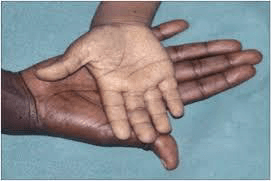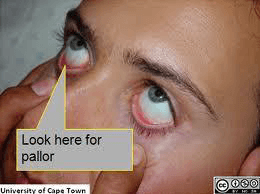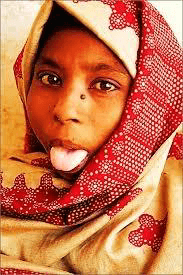An accurate way to measure fat-free mass is to measure the Upper arm circumference (MUAC). Is the circumference of the upper arm at midway between the shoulder tip and the elbow tip on the left arm. The mid arm point is determined by measuring the distance from the shoulder tip to the elbow and dividing it by two. A low reading indicates a loss of muscle mass.
Mid-upper arm circumference (MUAC) is a good screening tool in determining the risk of mortality among children, and people living with HIV/AIDS. MUAC is the only anthropometric measure for assessing nutritional status among pregnant women. Is also very simple for use in screening a large number of people, especially during community level screening for community-based nutrition interventions or during emergency situations.Mid upper arm circumference (MUAC) is therefore used as a screening tool for community-based nutrition program such as an outpatient therapeutic program (OTP), for a community- based intervention, supplementary feeding program, and enhancing outreach program throughout Ethiopia.
Measure the MUAC of children: A special tape is used to the MUAC of a child. The tape (Figure 10) has three colours, with the red indicates sever acute malnutrition (SAM), the yellow indicating moderate acute malnutrition and the green indicate normal nutritional status.
![]()
Procedures:

| Target Groups | MUAC (in cm) | Nutritional status |
|---|---|---|
| Children less than five years | 11- 11.9 cm | Moderate acute malnutrition (MAM) |
| < 11 cm < 11 cm | Sever acute malnutrition ( SAM) | |
| Pregnant women /adult | 17-21 cm | Moderate malnutrition |
| 18-21 cm with recent weight loss | ||
| < 17 cm | Sever malnutrition | |
| < 18 cm with recent weight loss |
As a Health Extension Worker, you are providing health service at community level. While providing the service you may find many people with nutritional deficiency problem. You came across anthropometric measurement method and now you are going to learn how nutritional status of an individual can be assessed using clinical methods that use the nutritional deficiency sign and symptoms.
The clinical method of nutritional status assessment involves checking the sign of nutritional deficiency at specific places on the body or asking the patient whether they have any symptoms that might suggest nutrient deficiency. The Clinical signs of nutrient deficiency include pallor (on the palm of hands or the conjunctiva of the eye), Bitot‘s spot on the eye, pitting oedema on the leg, severe wasting and goitre on the neck.
Checking for bilateral pitting oedema in a child
To determine the presence of oedema, apply normal thumb pressure on both feet for three seconds (count the number 101,102,102 to estimate three seconds without using a watch). If a shallow print persists on both feet, the child has nutritional oedema (pitted oedema).

Grades of oedema
Depending on the presence of oedema on the different levels of the body it is graded, an increase in grade indicates the severity of oedema.
0 = no edema
+ = below the ankle (pitting pedal oedema)
++ = pitting oedema below the knee
+++ = Generalized edema
Bitot’s spot
Bitot’s spot is a sign of vitamin deficiency, the spots are a creamy colour and appear on the white part of the eye.

Goitre
Goitre: is swelling on the neck and is a visible sign of iodine deficiency disease.

Visible severe wasting
To determine the presence of visible severe wasting for younger than six months child, you will need to ask the mother to remove all of the child‘s cloth so you can look at the arms, thighs, and buttocks for loss of muscle bulk. Sagging skin and buttock indicates visible severe wasting as you can see in the figure.

Pallor on the palm of hands or conjunctiva is a sign of Iron and folic acid deficiency is estimated to be responsible for half of all anaemia cases treating Iron deficiency anaemia decreases maternal and child mortality significantly.




| Sign or symptoms | Nutritional abnormality |
|---|---|
| Pale: palms, conjunctiva, tongue gets tired easily: loss of appetite, shortness of breath | Anemia |
| Bitot‘s spot (whitish patchy triangular lesions on the side of the eye) | Vitamin A deficiency |
| Goitre (swelling on the front of the neck) | Iodine deficiency disorder |
Biochemical assessment method: It is one of the nutritional status assessment methods. This method involves measurement of either total amount of nutrient in the body or concentration of nutrient in body fluid or organs in the body ( e.g. plasma albumin, other serum protein level and haemoglobin). The method is not practically done by the health extension worker.
Dietary methods of assessing nutritional status
Dietary methods of assessment involve looking the past or current intake of nutrients from food by individuals or group to determine their nutritional status. You can ask what the family or the mother and the child have eaten over the past 24 hours and use this data to calculate the dietary diversity score. Dietary diversity is a measure of the number of food groups consumed over a reference period, usually 24 hours.
There are two methods used to measure food consumptions at individual level
Household 24-hr recall method: Quantitative daily consumption methods ( current intake) consists of recalls or records designed to measure the quantity of the individual food consumed over a 1-day period and by increasing the number of days usual intakes can be obtained. The household member responsible for the food preparation is interviewed to obtain information about the household food consumption over the previous 24 hr period Provides data on the number of eating times in a day.
In the 24-hour recall method, subjects are asked to remember whatever they consume within the last 24 hours this include beverage and snacks. There are six nutrients that our body needs to have every day this can be presented in study session one on food guide pyramid.